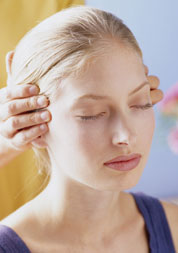

Feel Your Pain, Press it Away
The ancient art of acupressure can ease aches, naturally.
By Susan Weiner - from Energy Time Magzine, June 2005
The ancient art of acupressure can ease aches, naturally.
By Susan Weiner - from Energy Time Magzine, June 2005
 |
 |
| Nearly 4,000 years before Western medicine touted a
pill for every pain, indigenous peoples across the globe were long
practicing one of the oldest pain-relieving therapies to date. Without
the benefit of medical knowledge, but with the insight that stimulating
points in the body enhances the balance of energy, ancient cultures
intuitively grasped a hands-on remedy for easing pain. Using thumbs,
fingers, knuckles, palms and elbows, early acupressure practitioners
pushed on “tender” spots, triggering the release of pain-relieving
neurotransmitters and restoring the body’s natural healing abilities. Techniques varied from country to country, even from city to city, but the benefits of acupressure were far-reaching: This primal science was used by nearly everybody to treat medical maladies as diverse as headaches, cough, menstrual problems and constipation. Akin to acupuncture without needles, acupressure focuses on the concept that life-giving energy or qi (pronounced “chee”) circulates throughout the body in 12 main channels, or meridians. Along these meridians, specific acupressure points can relieve pain, inflammation and tension; by keeping energy on the move, acupressure can help treat or even prevent disease. The pressure applied can range from just the weight of a finger to deep, intensive massage, a practice sometimes called shiatsu. Acupressure is safe, simple, non-invasive and inexpensive, and self-acupressure techniques can be just as effective as those performed by a skilled therapist. “One of the reasons I practice acupressure is that I can teach it to other people,” says Cat Berry, LMT (licensed massage therapist), owner of Catalyst Touch in Ithaca, NY, who’s been applying acupressure for 30 years. Berry uses acupressure to treat back and neck pain, fatigue, jaw tension, women’s hormonal issues, emotional and mood imbalances, digestive upset and sleep disturbances, teaching clients self-acupressure along the way. “People with no background can learn a series of points that they can easily apply to themselves,” says Berry. “The body learns to rebalance itself.” |
|
| Under Pressure You don’t have to be a licensed anything to apply pressure to minor ills. Since acupressure can be self-learned and administered at home, nearly anyone can help ease chronic pain and improve overall health by literally lending themselves a hand. For the uninitiated, relief from everyday ailments like indigestion, headache, nausea and neck pain may be just an acupressure point away. Even the misery of allergies can vanish with the right technique: Steady pressure on the lower, outer corner of each nostril can reduce the anguish of seasonal sneezing and nasal symptoms. To take a break from that aching head, apply pressure to the indentation in the middle of the eyebrow, just above the pupil, or push on the point between the webbing of the thumb and the index finger. To get the most out of a self-acupressure treatment, set aside quiet time. After locating the point or points where you are going to apply pressure, push down using your thumb or fingers. Starting with a light touch, adjust the pressure accordingly and hold for 10 to 15 seconds. Soreness indicates a blockage, but do not press or massage to the point of severe pain. Repeat five to 10 times or until the pressure helps relieve symptoms; temporary soreness of the acupressure point is common and normal. Since chronic conditions such as neck pain or anxiety didn’t crop up overnight, these types of disorders require longer-term treatments. Just how acupressure works is open to debate. Hands-on modalities like acupressure are recognized as legitimate medical techniques and are used by tens of thousands of clinicians each year, yet science has yet to verify exactly how these treatments work. One theory is that the brain responds to pressure on certain points by releasing chemicals that activate the immune system into healing mode, as well as pain-relieving endorphins. Acupressure may also enhance electrical flow along nerves and between cells, improve blood and lymphatic circulation, and calm muscle tension. Allen Fein, MD, believes that acupressure, in combination with other hands-on techniques, balances the human energy field and elicits physiological changes. At his practice in Southampton, NY, Dr. Fein, Chief of the Department of Family Practice at Southampton Hospital, employs acupressure to reduce the pain and swelling of arthritis. He also uses it in treating fatigue, anxiety and back pain. At its core, acupressure is an instinctive reaction; when a child stubs a toe, he or she immediately rubs the painful digit. Since we already understand acupressure on an instinctual level, Fein suggests that nearly everyone learn more: “There are no boundaries to someone learning acupressure. It’s really the ultimate self-help, isn’t it?” Acupressure Techniques: A Self-Help Guide (Healing Arts Press), by Julian Kenyon, MD, provides easy-to-follow diagrams and guidelines for the inexperienced layperson. For more comprehensive information on acupressure, contact the Acupressure Institute, located in Berkeley, California, by calling 1-800-442-2232 or by visiting www.acupressure.com. |
|
|
Thank you for Energy Time Magzine
|
|